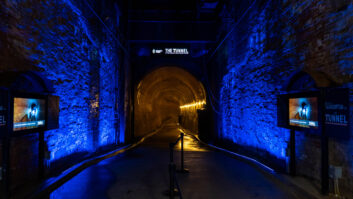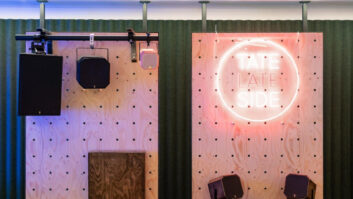It can now be revealed that Genelec loudspeaker systems, coupled with Absen LED screens, have been deployed to create a Formula 1 racing simulator by experienced AV engineer Andy Symonds and his CAVE Oy company. Symonds’ simulators, located at CAVE’s headquarters in Seinäjoki, Finland, are designed to provide young drivers with an opportunity to train in an environment that closely replicates the real-world conditions of Formula and GT racing.
Central to the realism of the simulators, which have been running for several months and already trained several young drivers, is the AV setup. Symonds chose to equip the Aston Martin simulator with 10 Genelec 8340 studio loudspeakers and two 7360 subwoofers, while the Formula 1 chassis simulator system comprises five 8351 studio loudspeakers and one 7380 subwoofer.
 The driver is seated in front of a 180-degree, 7m diameter curved Absen LED screen, with the loudspeakers arranged in upper and lower 5.1 layers to create an immersive sound environment.
The driver is seated in front of a 180-degree, 7m diameter curved Absen LED screen, with the loudspeakers arranged in upper and lower 5.1 layers to create an immersive sound environment.
The sound system replicates a range of racing noises – from the low, rumbling growl of the engine to the high-pitched squeal of the tyres gripping the track. Every sound is finely tuned to create the sensation of being on a real racing circuit.
The partnership with Genelec led to the creation of a charitable foundation, allowing young drivers in Finland, between the ages of 12 and 18, to access the simulators for free. In addition to the advanced technology, the facility provides access to data engineers and an experienced Formula 1 coach.
Symonds said: “The driver’s experience has to feel exactly like it would on a physical track. When it comes to the visuals, whether you’re using LED or projection, it’s relatively straightforward to replicate the race environment. But the audio is just as critical, and that’s something that can often be overlooked.”
He added: “We needed the audio to be loud enough to feel like you’re in an actual race car. It has to be powerful enough to cut through the helmet and padding that the driver wears, yet remain balanced and clear. That’s where Genelec’s expertise really came into play. Some drivers have told me that they forgot they weren’t on a real track during the session.”
An important element of both audio systems is Genelec’s GLM calibration software, which allowed Symonds to fine-tune the sound. “With just one click, we achieved the perfect balance. The software ensures that all acoustic issues are minimised, and the sound remains consistent. This technology added another layer of realism to the experience. The drivers feel like they’re really on the track, and the feedback has been overwhelmingly positive.”
While Formula 1 teams have used simulators for years as engineering tools, Symonds’ facility focuses on driver development rather than just car optimisation.
He concluded: “Formula 1 teams use simulators primarily to test, design and refine car performance. But here, we’ve created a tool that helps young drivers improve their knowledge of physical tracks, learn how to deal with challenges they might face during races, and enhance their driving skills in real-time situations.”







